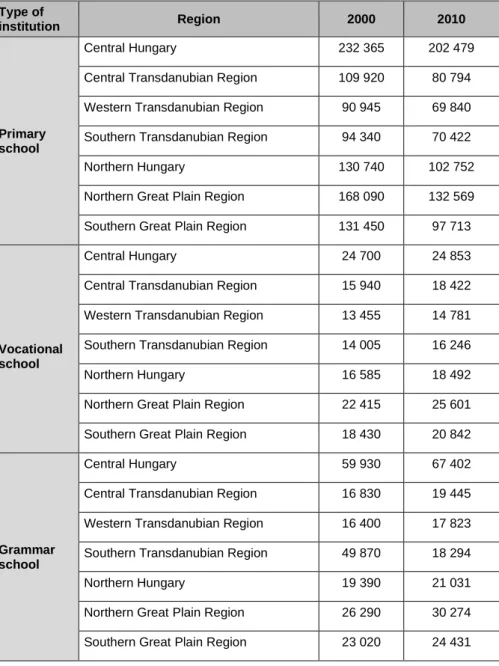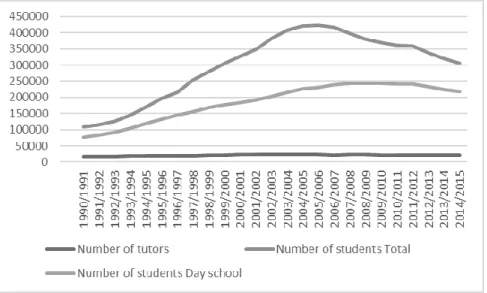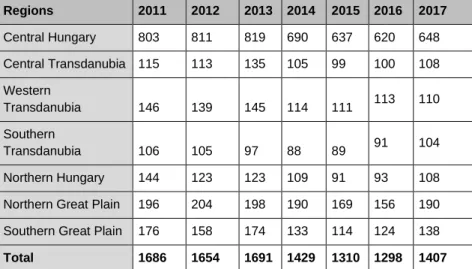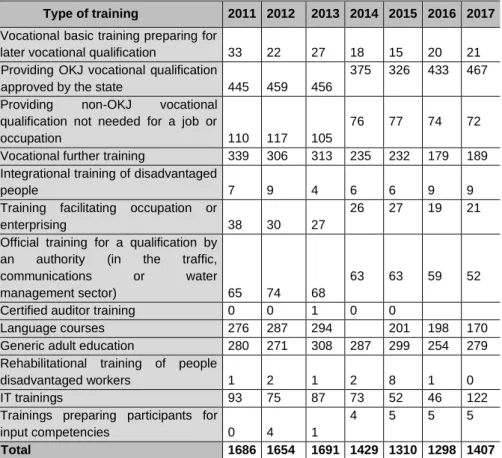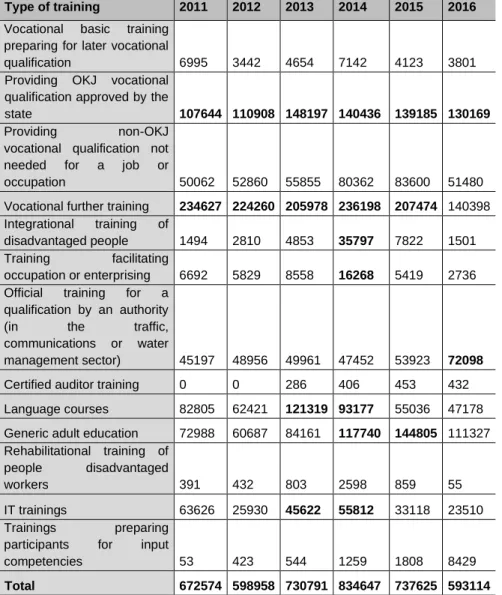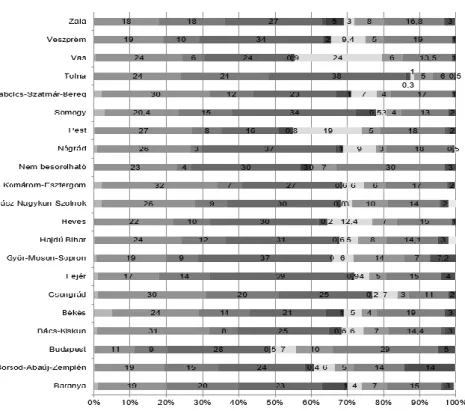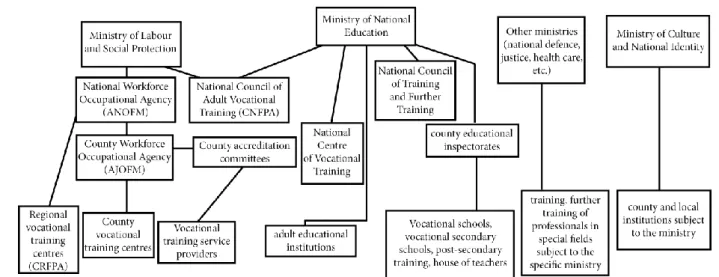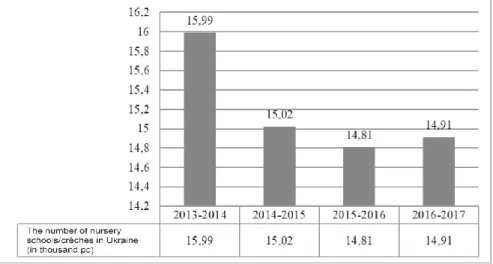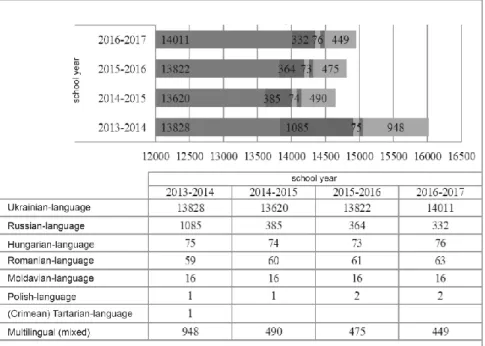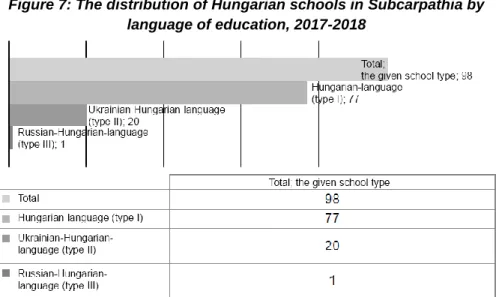L
EARNINGC
OMMUNITIES ANDS
OCIALT
RANSFORMATION: R
ESEARCHF
INDINGS INE
ASTERN ANDC
ENTRALE
UROPEClosing report of the research project
Nullpont Cultural Association
2019Editor:
Edina Márkus
Authors:
Tünde Barabási Silvia Barnová Ágnes Engler Mária Fabó Béla Gabóda Kornélia Gabri Rudolf Gabri Edina Márkus Viola Tamásová Piroska Zachar
Proofreading:
Balázs Benkei-Kovács Tamás Kozma
ISBN 978-615-00-7286-9
Research Findings in Eastern and Central Europe Closing report of the research project
Tartalom
Foreword ... 7 Studies on the educational and adult educational networks of the countries participating in the research ... 9
Ágnes Engler – Edina Márkus: Formal and non-formal adult learning
in Hungary ... 11 Tünde Barabási: Adult learning in Romania ... 33 Mária Fabó – Kornélia Gabri – Rudolf Gabri– Piroska Zachar: Education
in Slovakia, with special emphasis on adult education and training ... 55 Viola Tamásová – Silvia Barnová: A Summary of Education in Slovakia ... 69 Béla Gabóda – Éva Gabóda: Educating national minorities
in the native tongue in Ukraine (the Subcarpathian region) ... 77 Specificities of adult learning, adult learners’ motivation to learn ... 119
Edina Márkus: The specifics of adult learning, adult learners’ motivation
for learning ... 121 Edina Márkus – Ibolya Juhász-Nagy: Findings of the research
on the learning motivation of adult learners ... 138 Appendices ... 161
RESEARCH FINDINGS IN EASTERN AND CENTRAL EUROPE
F
OREWORDThe role of general learning and different skills (basic skills, key skills, management skills, citizenship skills, etc.) has intensified. Without having these skills professional knowledge is difficult to capitalise. The development of such knowledge and skills and their acquisition is possible via adult training for some social strata. Among other things, this is the reason why adult training (of both the vocational and general kind) has recently been granted an enhanced role in Hungary and the whole of Europe, with respect to both economics and social welfare. The relationship between vocational and general training, supplementing and benefitting from one another, is obvious.
Professional literature and examples in Hungary and abroad both prove that adult learning is not merely a concern of the economy. The importance of general trainings is highlighted because of their social role, too. The role of general training in social mobility is significant: it makes it possible for citizens to freely exercise their right to knowledge; it lays the foundations for and supplements vocational and labour market trainings as well as trainings in the workplace; it may contribute to the social integration of the most disadvantaged strata (young and adult dropouts, people with low educational qualifications, immigrants). A productive adult training programme can have a positive impact on not only indices on well-being and employment but also on health care.
In 2010 the European Union approved a medium-term economic programme that is based on knowledge, a high level of employment and an environmentally friendly economy. According to the professionals, the implementation of the program may be facilitated by a more active involvement of women and younger and older employees, a better integration of immigrants in the labour market, as well as a higher rate of employment and learning among people with lower educational qualifications.
RESEARCH FINDINGS IN EASTERN AND CENTRAL EUROPE
The goal of this research was to examine adult learners in the partner countries, to learn about their motivation to participate in trainings, their interest and the possible hindrances. In addition, we strove to map the areas of knowledge where adult learners are more active and find learning more effective as well as the methods of learning, which we analysed from several angles: on the one hand, whether they prioritised general, vocational or language trainings; on the other hand, the choices between formal, non-formal, cultural or community learning. We also intended to examine the institutions and sources of learning as well as the factors influencing the willingness to learn.
The closing report is divided into two greater units. The first part includes studies on the participating countries’ educational, adult educational and training networks. The second part describes the findings from the processed questionnaire used in the research.
The individual units have been created by different authors; therefore, for the sake of clarity, the referenced bibliography is listed after each study similarly to the numbering of figures and tables.
The editor
RESEARCH FINDINGS IN EASTERN AND CENTRAL EUROPE
STUDIES ON THE EDUCATIONAL AND ADULT EDUCATIONAL NETWORKS OF THE COUNTRIES PARTICIPATING IN THE
RESEARCH
Ágnes Engler – Edina Márkus
Formal and non-formal adult learning in Hungary
Formal learning
Formal education is performed in different types of educational institutions and at different levels. Public education traditionally provides primary qualifications (primary school, vocational school) and secondary qualifications through a final or maturity examination (vocational secondary school, grammar school); tertiary or higher education, granting a degree, is performed at universities and colleges. (The first level of public education, nursery school, is not discussed in this study.) The number of public educational institutions corresponds to a country’s prevailing social and economic status and is heavily influenced by demographics (that is, the number of babies born). Table 1 shows the number of different types of institutions in a regional breakdown, while Table 2 lists the number of students in public education.1 The numbers of schools and students are permanently prominent in Central Hungary, Northern Hungary and the Northern Great Plain Region in all school types, which is due to the rate of births, which higher in the latter two cases than the national average, and to intraregional migration induced by more favourable economic indices (resulting in population growth) in the former.
1 We have used the newest data available on the KSH website in our analyses, which in this case are from 2014.
Table 1: Number of premises of public education institutions, 2000-2016.
Type of
school Region 2000 2005 2010 2014 2016
Primary school
Central Hungary 740 704 690 768 773
Central Transdanubian
Region 448 422 391 417 419
Western Transdanubian
Region 489 448 391 404 393
Southern Transdanubian
Region 473 424 377 400 389
Northern Hungary
645 591 526 566 561
Northern Great Plain Region
587 554 518 594 587
Southern Great Plain Region
493 471 413 472 470
Vocational school
Central Hungary 132 143 150 158 152
Central Transdanubian
Region 78 86 104 99 91
Western Transdanubian
Region 67 73 81 72 77
Southern Transdanubian
Region 65 75 88 89 81
Northern Hungary 63 82 104 114 124
Northern Great Plain Region 96 117 155 191 132 Southern Great Plain Region
84 97 120 115 112
Grammar school
Central Hungary 206 249 253 267 264
Central Transdanubian
Region 66 84 87 95 95
Western Transdanubian
Region 54 63 66 63
62
Southern Transdanubian
Region 55 65 83 68 66
Northern Hungary 61 71 97 92 102
Northern Great Plain Region 94 130 171 183 202 Southern Great Plain Region 79 99 119 114 103
Type of
school Region 2000 2005 2010 2014 2016
Vocational secondary school
Central Hungary
221 262 248 247 216
Central Transdanubian
Region 101 96 112 112 88
Western Transdanubian
Region 94 97 97 88 76
Southern Transdanubian
Region 82 95 78 77 65
Northern Hungary 98 104 109 108 103
Northern Great Plain Region 116 152 157 176 158 Southern Great Plain Region 118 125 138 133 116 Source: Based on data from the Central Statistics Office, edited by the authors
Table 2: Number of students in public education in a regional breakdown, 2014, persons
Type of
institution Region 2000 2010
Primary school
Central Hungary 232 365 202 479
Central Transdanubian Region 109 920 80 794
Western Transdanubian Region 90 945 69 840
Southern Transdanubian Region 94 340 70 422
Northern Hungary 130 740 102 752
Northern Great Plain Region 168 090 132 569
Southern Great Plain Region 131 450 97 713
Vocational school
Central Hungary 24 700 24 853
Central Transdanubian Region 15 940 18 422
Western Transdanubian Region 13 455 14 781
Southern Transdanubian Region 14 005 16 246
Northern Hungary 16 585 18 492
Northern Great Plain Region 22 415 25 601
Southern Great Plain Region 18 430 20 842
Grammar school
Central Hungary 59 930 67 402
Central Transdanubian Region 16 830 19 445
Western Transdanubian Region 16 400 17 823
Southern Transdanubian Region 49 870 18 294
Northern Hungary 19 390 21 031
Northern Great Plain Region 26 290 30 274
Southern Great Plain Region 23 020 24 431
Type of
institution Region 2000 2010
Vocational secondary school
Central Hungary 67 870 66 171
Central Transdanubian Region 26 555 26 389
Western Transdanubian Region 25 755 26 411
Southern Transdanubian Region 20 755 18 990
Northern Hungary 31 955 31 803
Northern Great Plain Region 34 055 37 118
Southern Great Plain Region 32 355 33 482
Total 239 300 240 364
Source: Based on data from the Central Statistics Office, edited by the authors
In Table 3 we compared two data sets. The first shows the regional distribution of the number of students in a breakdown by training venue, the second the number of students in higher education as per their permanent residence. The number of higher education institutions is highest in the Central Hungarian Region due to the several universities and colleges found in the capital. The great appeal of the capital is clear here, as there are three times as many students here as the number of Budapest-based students (of course, not all Budapesters attend a metropolitan institution, but the rate of metropolitan youth studying out of town is presumably lower).
The two regions of the Great Hungarian Plain are important hubs of rural higher education. With regard to student population Baranya County is prominent of the Transdanubian counties. Traditional great rural universities and their catchment areas constitute the hubs of Hungary’s higher education; their student base is characteristically informed by the regional districts. The higher educational regions thus created do not necessarily correspond to the divisions by design and statistical regions: for instance, students of the University of Debrecen come from Hajdú-Bihar, Szabolcs- Szatmár-Bereg and Borsod-Abaúj-Zemplén counties as well as from across borders (primarily from Transylvania and the Subcarpathian region).
This is the reason why in Hajdú-Bihar, for example, there is a significant difference between student numbers as per training venue and as per permanent residence, where the former outnumbers the latter. At the same time there are twice as many local residents of Borsod-Abaúj-Zemplén County who have enrolled in some institution as the number of university students in the county. The same may be observed in Csongrád and Baranya counties, where the drain effect of Szeged- and Pécs-based universities is felt. The situation is the opposite in all the counties of the Northern Hungarian region, from where young students migrate to the capital or the higher education institutions of Hajdú-Bihar. In Central and Western Transdanubia there are higher local student numbers in comparison to the training centres’ headcounts. In all probability most of the local residents continue their studies in Budapest, as in the aforementioned regions there are no counties with a prominent student headcount (similarly to Baranya in Southern Transdanubia).
Table 3: Number of students in higher education bachelor’s and master’s courses in a breakdown by training venue and the students’
permanent residence, in persons, 2014, 2016 Student
numbers as per training venue, 2014
Student numbers as per
training venue, 2016
Student numbers as per permanent residence, 2014
Student numbers as per
permanent residence, 2016
Budapest 107 514 104321 35 297 32051
Pest 5 674 4318 22 946 22297
Central
Hungary 113 188 108639
58 243 54348
Fejér 1 799 1215 7 290 6350
Komárom-
Esztergom 402 243
5 007 4447
Veszprém 3 549 2916 6 232 5536
Central Transdanubian
Region 5 750
4374
18 529
16333
Student numbers as per training venue, 2014
Student numbers as per
training venue, 2016
Student numbers as per permanent residence, 2014
Student numbers as per
permanent residence, 2016 Győr-Moson-
Sopron 10 403 9064
7 960 7275
Vas 1 532 1317 4 725 4291
Zala 1 731 1553 5 470 4903
Western Transdanubian Region
13 666
11934
18 155
16469
Baranya 13 293 12989 6 628 6114
Somogy 1 704 1714 4 883 4387
Tolna 369 293 3 741 3392
Southern Transdanubian Region
15 366
14996
15 252
13893
Borsod-Abaúj-
Zemplén 6 726 5955
11 974 10544
Heves 3 371 2873 5 768 5163
Nógrád – - 3 020 2681
Northern
Hungary 10 097 8828
20 762 18388
Hajdú-Bihar 21 002 19304 11 465 10348
Jász-Nagykun-
Szolnok 628 370
6 331 5474
Szabolcs-
Szatmár-Bereg 2 903 2234
10 840 9933
Northern Great
Plain 24 533 21908
28 636 25755
Bács-Kiskun 2 385 2049 9 452 8330
Békés 647 392 6 160 5350
Csongrád 17 387 16382 8 115 7463
Southern
Great Plain 20 419 18823
23 727 21143
Source: Based on data from the Central Statistics Office, edited by the authors
With regard to the nationwide trends of student numbers in higher education we may establish that the expansion that blossomed in the 1990s significantly inflated the student headcount in all school types (Fig. 1). After the halt experienced in the mid-2000s the increase of student numbers in day school (full-time students) continued moderately, whereas it lapsed significantly in correspondence courses (night school and distant education always appealed to a low number of students in Hungarian higher education in the years under survey). In the meantime staff headcounts remained relatively unchanged.
Figure 1: Number of students in higher education: day school and part-time students, as well as staff numbers between 1990 and 2015,
persons
Source: Based on data from the Central Statistics Office, edited by the authors
Adult education related to different levels of education primarily performs gap-filling and correctional functions. The chances of occupation and further education (e.g. vocational qualification) of people with low educational qualifications or without any qualifications are both enhanced by making up for missed learning in primary or secondary school. The number of adults attending primary school is rather low, which is due to the improving educational indices of the population; on the other hand, the proportion of people who haven’t finished even their fourth year is still relatively high. The expansion in secondary education (in the 1970s and 1980s) had an impact on adults taking their school-leaving (“matura”) examination, too. Following the saturation, however, the number of such learners gradually waned, while the generations attracted to day school by the expansion of secondary education grew up to be adults. This generation became involved in the massification of higher education, too, since the expansion wave reached the day courses in higher education in the early 1990s.
The number of students in part-time (night and correspondence) courses of higher education also increased after that, and people with an intention of graduating as adults flooded the universities and colleges. The institutions reacted sensitively to adults’ demand for higher education, increasing their choice of courses. The studies of these people, arriving via the “backstairs”
(Ladányi 1994) of higher education, are judged differently from those of day- school students (e.g. they follow a very different path to learning, there is no possibility to immerse themselves in the material learnt and to consult their tutors in style, there are different requirements), but after the heterogenisation of day school the differences appeared to fade away.
Higher education’s methodology (e.g. the lack of practical orientation) and organisation of studies (e.g. the lack of validation of prior knowledge and skills) do not treat part-time students differently, most of whom have labour market experience (Maróti 2002, Derényi and Tót 2011). Little attention is paid to the learning difficulties and demands of students who characteristically study while having a job and/or a family (Tőzsér 2013, Engler 2014).
Defining which students belong in adult education may be carried out on the basis on different criteria: biological and psychological maturity, economic activity, an own living, having a family. The legal approach standardises the decision: the law draws the line at a certain age. Legal adulthood does not always correspond to the legal school-leaving age. The school-leaving age was modified several times after the change of regime (from 16 to 18 in 1996, then back to 16 in 2012). The debates on school-leaving age view the problem of school years basically from different standpoints: according to advocates of legal adulthood (18 years of age) attending school postpones the time of making important decisions about one’s career and job, leaving ample time for personal development and the maturation of interests and skills. The reason for keeping young people in the educational system is providing a foundation for life-long learning, but another significant reason is the prevention of unemployment. Advocates of a school-leaving age of 16 (or 14) wish to provide the social stratum that amasses learning failures, truancy and dropping out with early work experience and an own living, not excluding the possibility of further education (c.f. Fazekas et al. 2008, Halász 2010, Mártonfi 2011, Fehérvári et al. 2011).
In Hungary adults’ institutional learning primarily appears at tertiary level.
The data in Table 4 make it obvious that the higher the educational level, the higher the proportion of adult learners in the courses. Based on the time-series data from the Central Statistics Office and the educational annals it can be established that as a result of an improvement in the populace’s educational level the number of adults enrolled in primary public education institutions is definitely dwindling. At secondary level the night schools of grammar schools providing a matura exam are popular with former dropouts. Although the changes in higher education (expansion, the Bolognai process) had an impact on the enrolment tendencies among adult learners, the correspondence course arrangements supplied by colleges and universities are still the most appealing for people wishing to learn.
Table 4: The number and proportion of full-time and part-time students at educational institutions in the academic year 2014/2015
Number of students
Primary school
Vocational school
Vocational sec. school
Grammar school
Higher ed.
Total number of students, in persons
751 034 109 978 221 144 216 368 306 524 Part-time
students, in persons
2 548 9 946 32 382 34 140 89 276
Percentage of part-time students of total number of students
0.3 9.0 14.6 15.8 29.1
Source: Based on data from the Central Statistics Office, calculated and edited by the authors
Non-formal adult learning
The term ‘non-formal learning’ is used in a broad sense in the study, as we discuss its elements of general learning as well as vocational training, with special emphasis on the institutions and students of adult education outside the public educational system. Beyond reviewing the number, areal distribution and defining training characteristics of the institutions, approaching from the participants’ side, we analyse the proportion of adults in the trainings and the areal and regional characteristics of such participation. Koltai (2005) and Farkas et al. (2011) carried out surveys on the non-formal field, but by another method, focussing specifically on accredited institutions and programmes, through questionnaires.
With regard to adult education in Hungary we have access to several different records, in addition to the records of institutions and adult education trainings that have passed the certification processes, we have available data from the adult education statistical data of OSAP 1665 as well as data collected from the data supply of community cultural and public collection institutions. In our work we use the OSAP 1665 database.
We have chosen this because we may find data on learners (or rather participants, when discussing adult education outside the school system) in a regional breakdown by type of training.
OSAP 1665 adult education statistics holds data2 on trainings outside the public education system.3 It must be mentioned that the OSAP database is often criticised for being incomprehensive, because several organisations do not comply with their data supply obligation. Yet, looking at the number of data supplying organisations and institutions in the past years, there is no extraordinary deviation.
The following table (Table 5) delineates the number of institutions providing trainings between 2011 and 2017 in regional breakdown. By 2015 there is a substantial decrease, which in our opinion is due not to failure to meet the data supply obligation, as the number of institutions between 2011 and 2013 was relatively permanent, but due to a restructuring following the adult education act of 2013. Beyond the decrease in the number of organisations the regional proportions did not shift: the number of organisations is higher in Central Hungary as well as the Northern and Southern Great Plains and Western Transdanubia. This is probably due to another reason: the Northern and Southern Great Plains have a favourable situation when it comes to distribution of funds owing to their disadvantaged status. Also, in Central Hungary and Western Transdanubia there is a presumably greater and more solvent demand for adult trainings, either financed by individuals or by workplaces. Yet, it also clearly shows that by 2017 the number of organisations is on the rise again.
2The data refer to the following characteristics of the trainings: type, number of hours, time, form, job code that the qualification qualifies for (FEOR code), the lowest school qualification required for the training, venues of theoretical and practical training, the participation fee, the parties funding the training fee of the enrolled, the institution organising the examination, the number of participants enrolled in the training listed in the OKJ (National Training Register), the labour market status of the participants, groups of the participants (age group, educational qualifications).
3 As per Act No. LXXVII of 2013 on adult education and Govt. Decree No. 288/2009 (XII. 15.) on the data collections and data takeover of the National Statistical Data Collection Programme, the obligation to notify burdens the institution providing the training, and the time of notification is the 10th day from completing the exam/training, and in the case of official trainings or those with a duration shorter than 25 hours, the 10th day after the year of the
Table 5: The number of organisations providing trainings by regions, 2011-2017.
Regions 2011 2012 2013 2014 2015 2016 2017 Central Hungary 803 811 819 690 637 620 648 Central Transdanubia 115 113 135 105 99 100 108 Western
Transdanubia 146 139 145 114 111 113 110
Southern
Transdanubia 106 105 97 88 89 91 104
Northern Hungary 144 123 123 109 91 93 108
Northern Great Plain 196 204 198 190 169 156 190 Southern Great Plain 176 158 174 133 114 124 138 Total 1686 1654 1691 1429 1310 1298 1407
Source: OSAP 1665 https://statisztika.mer.gov.hu/
Examining the institutions providing trainings for their types (Table 6), we may establish that between 2011 and 2017 the proportion of institutions that provide vocational training (providing OKJ vocational qualification approved by the state or vocational further training) is bigger, but the number of language courses and generic adult education trainings is not insignificant either.
Table 6: The number of institutions providing training by type of training, 2011–2017.
Type of training 2011 2012 2013 2014 2015 2016 2017 Vocational basic training preparing for
later vocational qualification 33 22 27 18 15 20 21 Providing OKJ vocational qualification
approved by the state 445 459 456
375 326 433 467 Providing non-OKJ vocational
qualification not needed for a job or
occupation 110 117 105
76 77 74 72
Vocational further training 339 306 313 235 232 179 189 Integrational training of disadvantaged
people 7 9 4 6 6 9 9
Training facilitating occupation or
enterprising 38 30 27
26 27 19 21
Official training for a qualification by an authority (in the traffic, communications or water
management sector) 65 74 68
63 63 59 52
Certified auditor training 0 0 1 0 0
Language courses 276 287 294 201 198 170
Generic adult education 280 271 308 287 299 254 279 Rehabilitational training of people
disadvantaged workers 1 2 1 2 8 1 0
IT trainings 93 75 87 73 52 46 122
Trainings preparing participants for
input competencies 0 4 1
4 5 5 5
Total 1686 1654 1691 1429 1310 1298 1407
Source: OSAP 1665 https://statisztika.mer.gov.hu/
Table 7 shows the number of people that completed adult education trainings outside the school system between 2011 and 2016, in a county breakdown. We may establish that besides Budapest and Borsod-Abaúj- Zemplén County, Hajdú-Bihar, Szabolcs-Szatmár-Bereg and Győr-Moson- Sopron counties have the highest number. These data partly correspond to the data on institution numbers, as the number of institutions is higher in Central Hungary, the Northern Great Plain and Western Transdanubia.
Table 7: The number of people that completed their trainings in a breakdown by counties (2011-2016)
Venue of the training
(county) 2011 2012 2013 2014 2015 2016
Baranya 22858 21870 26950 30280 24939 14111
Borsod-Abaúj-
Zemplén 32019 27955 39941 63309 56055 22719
Budapest 289378 250199 234614 255160 264530 271151
Bács-Kiskun 27491 24312 31882 36771 25279 22719
Békés 14681 12630 18063 19683 15369 8308
Csongrád 22345 18013 26410 34114 27023 18493
Fejér 21515 17858 29189 29046 28475 19646
Győr-Moson-
Sopron 34163 40560 53055 45632 41109 36157
Hajdú-Bihar 28719 24718 40068 64663 42814 26255
Heves 13288 13445 17795 24382 19355 12794
Jász-Nagykun-
Szolnok 16166 14601 22961 30114 18922 11042
Komárom-
Esztergom 14846 11201 15178 14823 14684 12012
N/A 0 0 0 1176 335 0
Nógrád 7081 7377 10442 11292 9412 3500
Pest 39722 29203 36503 33373 32306 28847
Somogy 15297 11806 18770 19032 15700 10712
Szabolcs-
Szatmár-Bereg 22207 22679 38317 49245 36977 23784
Tolna 8042 8868 14688 12491 11465 8628
Vas 15454 17326 22125 21583 16557 14992
Veszprém 13954 11298 17950 21309 20312 13064
Zala 13348 13039 15890 17169 16007 8939
Total 672574 598958 730791 834647 737625 593114 Source: OSAP 1665 https://statisztika.mer.gov.hu/
Taking the number of people that completed their trainings in a breakdown by the type of training (Table 8), it is obvious that the number of vocational trainings4 is approximately the same, and in the case of some trainings (integrational training of disadvantaged people; trainings to facilitate occupation or enterprising; language courses, generic adult education, IT trainings) the number is above average, which is due to the singular projects financed from EU funds. The increase in the number of participants in language and IT courses is probably due to the programme called ‘Your knowledge is your future’, whereas the number of participants in the generic trainings might have been influenced by the trainings for public sector employees.
4 Trainings of the vocational type: providing OKJ vocational qualification approved by the state, providing non-OKJ vocational qualification not needed for a job or occupation and vocational further
Table 8: The number of people that completed their trainings, by type of training (2011-2016)
Type of training 2011 2012 2013 2014 2015 2016 Vocational basic training
preparing for later vocational
qualification 6995 3442 4654 7142 4123 3801
Providing OKJ vocational qualification approved by the
state 107644 110908 148197 140436 139185 130169
Providing non-OKJ
vocational qualification not needed for a job or
occupation 50062 52860 55855 80362 83600 51480
Vocational further training 234627 224260 205978 236198 207474 140398 Integrational training of
disadvantaged people 1494 2810 4853 35797 7822 1501 Training facilitating
occupation or enterprising 6692 5829 8558 16268 5419 2736 Official training for a
qualification by an authority
(in the traffic,
communications or water
management sector) 45197 48956 49961 47452 53923 72098
Certified auditor training 0 0 286 406 453 432
Language courses 82805 62421 121319 93177 55036 47178 Generic adult education 72988 60687 84161 117740 144805 111327 Rehabilitational training of
people disadvantaged
workers 391 432 803 2598 859 55
IT trainings 63626 25930 45622 55812 33118 23510
Trainings preparing participants for input
competencies 53 423 544 1259 1808 8429
Total 672574 598958 730791 834647 737625 593114 Source: OSAP 1665 https://statisztika.mer.gov.hu/
Examining the number of people that completed their trainings in 2015 in a breakdown by counties and types of training (Fig. 2), we may see that trainings providing OKJ vocational qualification approved by the state, vocational further trainings and generic adult education trainings have the highest numbers of participants. Vocational trainings (including the following: providing OKJ vocational qualification approved by the state, providing non-OKJ vocational qualification not needed for a job or occupation and vocational further training) are more significant.
In the case of vocational trainings there is a difference in the distribution of trainings among the types, whether the number of participants is higher in the ones providing OKJ vocational qualification approved by the state, the ones providing non-OKJ vocational qualification not needed for a job or occupation, or the vocational further trainings.
Figure 2: The number of people that completed their trainings by county and type of training, 2015
(Source: OSAP 1665 https://statisztika.mer.gov.hu/)
The changing numbers are probably not due primarily to an increase or decrease in the willingness to learn, but to the shifts in supply and financial funds. These together influence the sector. The differences between regions and counties may correspond to changing funds (EU subsidies) as well as the various demands in the given regions and counties.
Regarding the fact that here we do not see a vertical structure – as opposed to trainings in the educational system –, the total number of participants well defines the system, that is, it has indicator value (Györgyi 2015).
Summary
With respect to the numbers of institutions of formal and non-formal learning and the corresponding regions we may establish that in both forms of learning the number of institutions is highest in the regions of Central Hungary and the Northern Great Plain. Beyond this, in the formal tier, higher numbers are observable in Northern Hungary, and in the non-formal tier, in the Western Transdanubian and Southern Great Plain regions. This is due partly to favourable or unfavourable economic situations, and partly to demographics.
Reviewing the data, there is no functional correlation between participation in formal and non-formal adult education, in regions with a lower level of formal learning the number of participants in non-formal learning is not higher. Low or high participant numbers in both tiers is characteristic of the given region. On the basis of available data we were not able to discern any function of non-formal adult education which would compensate for or supplement formal education.
Bibliography
▪ Bajusz, Klára (2008): Felnőttek az iskolapadban? Az iskolarendszerű felnőttoktatás helyzete és problémái [Back to school? The situation and problems of adult education within the school system]. In: István Bábosik (ed.). Az iskola korszerű funkciói [The modern functions of school]. Budapest, Okker. 60-75.
▪ Csoma, Gyula (2002): Felnőttoktatási sajátosságok [The peculiarities of adult education]. In: József Mayer and Péter Singer (eds.).
Módszertani stratégiák az iskolarendszerű felnőttoktatásban 1. – Problémák, kérdések – megoldások, válaszok [Methodological strategies in adult education within the school system]. Budapest, Országos Közoktatási Intézet. 72-104.
▪ Engler, Ágnes (2014): Hallgatói metszetek: A felsőoktatás felnőtt tanulói [Adult learners in higher education]. Debrecen, Debreceni Egyetem Felsőoktatási K&F Központ.
▪ Derényi, András and Éva Tót (2011): Validáció: A hozott tudás elismerése a felsőoktatásban [Validation of former knowledge in higher education]. Budapest, Oktatáskutató és Fejlesztő Intézet.
▪ Farkas, Éva, Erika Farkas, Dóra Hangya and Hajnalka Leszkó (2011): A dél-alföldi régió akkreditált felnőttképzési intézményeinek működési jellemzői [Functional characteristics of the accredited adult education institutions of the Southern Great Plain region]. Szeged, SZTE Juhász Gyula Pedagógiai Kar Felnőttképzési Intézet.
▪ Fazekas, Károly, János Köllő and Júlia Varga (eds.) (2008): Zöld könyv a magyar közoktatás megújításáért [Green book for the renewal of Hungarian public education]. Budapest, Ecostat.
▪ Fehérvári, Anikó, Anna Imre and Gábor Tomasz (2011): Az oktatási rendszer és a tanulói továbbhaladás [The educational system and further learning]. In: Éva Balázs, Mihály Kocsis and Irén Vágó (eds.).
Jelentés a magyar közoktatásról 2010 [A report on Hungarian public education]. Budapest, Oktatáskutató és Fejlesztő Intézet. 133-97.
▪ Halász, Gábor (2010): Oktatáspolitika az első évtizedben [Educational policy in the first decade]. In: Éva Balázs, Mihály Kocsis and Irén Vágó (eds.). Jelentés a magyar közoktatásról 2010 [A report on Hungarian public education]. Budapest, Oktatáskutató és Fejlesztő Intézet. 17-35.
▪ Felkai, László (2002): A felnőttoktatás története Magyarországon [The story of Hungarian higher education]. In: József Mayer and Péter Singer (eds.). Módszertani stratégiák az iskolarendszerű felnőttoktatásban. 1. Problémák, kérdések – megoldások, válaszok [Methodological strategies in adult education within the school system]. Budapest, Országos Közoktatási Intézet 7-18.
▪ Györgyi, Zoltán (2015): Szakképzés I. – Országos szint [Vocational training]. In: Tamás Kozma et al. Tanuló régiók Magyarországon: Az elmélettől a valóságig. Debrecen, Debreceni Egyetem Felsőoktatási K&F Központ 116-27.
▪ Koltai, Dénes (2005): Felmérés a hazai akkreditált felnőttképzési szervezetek működéséről [A survey on the operation of Hungarian adult education organisations]. Budapest, Nemzeti Felnőttképzési Intézet.
▪ Ladányi J. (1994): Rétegződés és szelekció a felsőoktatásban [Stratification and selection in higher education]. Budapest, Educatio.
▪ Maróti, Andor (2002): Hatékonyabbá tehető-e a levelezős oktatás?
[Can correspondence courses be made more efficient?]. In: A tanári mesterség gyakorlata: Tanárképzés és tudomány [The practice of the art of teaching]. Budapest, Nemzeti Tankönyvkiadó – ELTE Tanárképző Főiskolai Kar.
▪ Mártonfi, György (2011): A 18 éves korra emelt tankötelezettség teljesülése és (mellék)hatása [Realisation and side effects of the school-leaving age raised to 18]. Budapest, Oktatáskutató és Fejlesztő Intézet.
▪ Mayer, József (2003): A tanulási környezet átalakulása az iskolarendszerű felnőttoktatásban [The transformation of learning environment in adult education within the school system]. In: József Mayer and Péter Singer (eds.). Módszertani stratégiák az iskolarendszerű felnőttoktatásban 5. – Tanári kulcskompetenciák [Methodological strategies in adult education within the school system]. Budapest, Országos Közoktatási Intézet.
▪ Mayer, József (2006): A munkaerőpiac elvárásai és az iskolarendszerű felnőttoktatás. In: Educatio 15.2. 288-304.
▪ Márkus, Edina (2014): Az általános képzést végző intézmények regionális megközelítésben [Institutions offering generic trainings from a regional perspective]. In: Képzés és gyakorlat 22.3-4. 2-25.
▪ Schoof, U. M. Blinn., A. Schleiter, Elisa Ribbe and J. Wiek (2011):
Deutscher Lernatlas. Ergebnisbericht 2011. Gütersloh, Bertelsmann Stiftung.
▪ Tőzsér, Zoltán (2013): Részidős hallgatók a felsőoktatásban [Part- time students in higher education]. In: PedActa 3.2. 27-38.
Tünde Barabási
Adult learning in Romania
Historical background
Directly before 1989 the concepts ‘adult education’ and ‘adult training’
appeared in Romania as an interpretation of the term ‘mass culture’, subjected to the ruling political ideology, in service thereof, hardly a scene of learning.
Examining the previous period, however, Sava (2007) asserts that different epochs may be distinguished in Romanian adult education.
The first, initial phase came to its own in the 19th century, when several new initiatives were launched with the purpose of educating and sophisticating the people. The primary goal of these was to raise the people through learning. In Romania one of the most significant in this period was ‘Școala Ardeleană’, whose illustrious representatives authored textbooks and books addressed to the people with the intent to enlighten them. At this time several organisations were born, which launched cultural movements (e.g. ASTRA), published periodicals and established libraries.
Different church organisations had a substantial role to play, too. The Law on Education of 1864 already supported the learning activity of adults, and the Societatea pentru învățătura poporului român was set up, which was determined to promote the learning of the masses. With respect to the Hungarian minority, the Transylvanian Hungarian Community Cultural Association (EMKE) was prominent in encouraging adult learning, with the following goals: to reinforce the Hungarian language and national identity, especially in isolated communities of Transylvanian Hungarians; to establish cultural institutions, also mainly in isolated communities: nursery schools, adult education centres, libraries, choirs, etc. and literacy courses, spreading the Hungarian language; as well as to promote the economic elevation of Hungarian communities (Sándor 2009). In this period schools became training and cultural centres for adults, too, since primarily in rural areas they provided the only way to cultural learning.
At the same time both in the towns and the country cultural clubs and conferences were organised as an opportunity for adult learning.
The second phase lasted from the early 20th century to the Second World War. While in the first phase, the education of adults was realised through presentations held at different venues as well as the aforementioned conferences and was consequently fragmented and contingent, in the second phase it became more regular and institutionalised. A prominent personality in this period in Romania is Dimitrie Gusti, who strove to ensure cultural advancement by taking field trips to Romanian villages with his colleagues, learning about their reality, disclosing cultural and learning demands and needs, preparing the ‘village’s pedagogy’ and trying to ‘raise the villagers to their own era’ (Sava 2007, 71). At the same time several adult education centres were established in the period: Universitatea Populară de la Vălenii de Munte, Școala Superioară Țărănească de la Poiana Câmpina, etc. The most productive stage in this second phase of Romanian adult education was the interwar period, in which the emphasis was on the cultural demands of disadvantaged villagers and on providing opportunities to satisfy those needs.
The third phase lasted from the Second World War to 1989. Without denying advancements in this period directed at the annihilation of illiteracy and raising interest in culture, in summary we may establish that all initiatives bear the trace of party ideology. Owing to that, neither cultural activities (realised with the intent to ensure equal access to cultural values, but with a character lauding the Party, which mostly aroused opposition from the people), nor the characteristics of adult education (which made participation in further trainings every five years obligatory, and where a significant part of the ‘teaching material’ was listing realisations by the Party and setting further goals) promoted the full establishment of adult educational system. Flóra, Győrbíró and Szilágyi (2012) also emphasise that the real roots of Romanian adult education go back to the period between the two world wars, when ‘people’s universities’ and ‘peasants’
colleges’ were established in many towns of the country, which set as their main goal the cultural improvement and community learning of the agricultural people of villages.
In the period of communist rule this kind of activity was greatly extended and filled with ideological content appropriate to the regime; besides villagers, city-dwellers and industrial workers were regarded as a target group.
After 1989, according to Pepelea (2011), adult education initiatives started rather slowly. First they attempted to reorganise former models, the purpose of which was primarily to train adults in generic trainings and enlarge professional knowledge. The initiatives to set up institutions based on western models, including development workshops for trainers’ trainers, could be regarded as more efficient.
Simona Sava (2005) divides the period after 1989 into three further parts, which well exemplify the developmental stages of Romanian adult education:
a. In the first three years after the demise of the socialist- communist regime there was a strong decline of interest in adult education, as the developmental endeavours were focused more on ensuring economic balance and coherent politics. As a result, since education in general and adult education in particular was not allotted enough attention and funds, over half of the adult education institutions (operating under the supervision of the Ministry of Culture) terminated their operation in this period.
b. The period of continuous rebuilding and a search for a development strategy lasted from 1993 to 1997. The difficulties of the transitional economic situation manifested themselves in adult education, too. A possibility to create a diversified choice of trainings appeared, and the field was decentralised, but no financial funds could be allocated for the opportunities. Despite all that the progress was evident. On 23 February 1993 the National Association of Adult Education Centres (Asociația Națională a Universităților Populare) was set up, which unified over 100 of the 360 adult education centres then existing in Romania (Pepelea 2011).
The establishment of the association is significant also because it became a member of the European Association of Adult Education, and thus several international cooperative projects were realised. These projects revivified the domestic adult education system, too. In the same period, a number of new professions as well as unemployment appeared (unknown
in the socialist-communist regime), and realising that the Ministry of Labour and Social Protection started to spend massive amounts on the vocational training of the unemployed and on programmes designed to rehabilitate disadvantaged people. At that time several new institutions conducting permanent retraining were created (in 1996 there were 14 regional centres countrywide, operated by the Ministry, which were mainly designated to train and retrain the unemployed). Numerous state-owned and private institutions were created in the period, and these tried to adjust their training choice to adults’ training demands mostly in the form of further trainings.
c. According to Sava (2007), the third phase after the changes is the period after 1997. The phase itself presents a step forward for several reasons: firstly, because the National Association of Adult Education Centres increasingly encouraged the creation of an adult education law (which was passed in 2000); secondly, the awareness-raising effect of international conferences was observable in the professionals; and thirdly, the National Ministry of Education’s (Ministerul Educației Naționale) interest in adult education was increased. As a result, key institutions were created (Romanian Council of Adult Vocational Training <CNFPA>, Council of Occupational Standards <COSA>, etc.), which played a significant role in developing and effectuating the adult education law and also actively contributed to the professionalization of adult education. At the same time, the National Ministry of Education encouraged the development of university further training programmes, for which appropriate funds were created, too. Owing to these the universities established their choice of distant education and correspondence courses.
Another measure of the Ministry was to validate the certificates granted by different adult education institutions. In 2000 a government decree (OG 129/2000) was passed, which regulated the vocational training of adults.
Even though there was a lack of synchronisation between theory and practice due to the conceptual chaos, the attention paid to the field was ahead of its time, and the change was marked by a transformation of such institutions and a much broader practice (adult education conferences – Temesvár 2001, 2006; Jászvásár – 2002, 2005, 2006, etc.; the Romanian Institute of Adult Education is established <Institutul Român de Educare a
In the second half of the period, on the threshold of Romania’s EU accession, also to meet the requirements of the Community, a whole range of supplementary regulations were released, attention became much more regular and ever greater amounts are now being spent on adult education (even though the sums do not cover the demands sector). In summary we can state that the practice of adult education is being continually optimised owing to the accumulation of theoretical research and practical experience.
Statutory background
János Márton (2005a) divides the laws on adult education and training in Romania after the change of regime into three periods:
• 1990–1994: vocational training for adults, as a form of training for the unemployed;
• 1995–2001: the appearance of adult education and training as well as the concept of life-long learning, in parallel to the vocational training of the unemployed;
• 2002–2004: a change in the vocational training of the unemployed and a practical application of adult education laws;
• This is supplemented with a new period, from 2004 to today – in which adult training is organised in terms of the laws and methodology created in the previous periods, but there is an unfortunately low efficiency of attracting the target group (lowest in the European Union – Comisia Europeană, 2016)
The characteristic traits of the individual periods are listed as per the aforementioned study (see Márton 2005a, 122-24)
a). The period between 1990–1994:
In this period adult education as such was not mentioned in any of the laws. The training of adults was primarily a social problem, part of the policy to mitigate unemployment. The two laws from this period are: Act 1991/1 on unemployment and Govt. Decree No. 1991/288 on the training and retraining of unemployed people. In these laws vocational training appeared as a tool of reducing unemployment by training and retraining unemployed people. In addition, there were other provisions for non-
